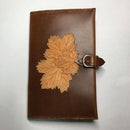Introduction: Leather Scale Armor
In this Instructable, I'm going to teach y'all how to make leather scale armor. When I was a kid I loved making armor out of duck tape, and I made a full scale armor set that was super fun to wear, but obviously not very high quality. I wanted something more durable, classy, and historically based, so I chose leather. The style of armor is inspired by historical scale armor (or scale mail), an early form of armor consisting of many individual small scales of various shapes attached to each other and to a backing of cloth or leather in overlapping rows. Scale armor was worn by warriors of many different cultures as well as their horses. It's flexible and protective, and quite frankly, looks epic.
This is a great project for someone that has only basic tools and leather working skills, but still wants to make something awesome.
First two images by Nicolas Bruno
Supplies
- Full grain leather (I got mine from springfieldleather.com, it's their Boot Strap Brown oil tan)
- Leather hole punch
- Scissors
- Rivets
- 4 buckles
- Rivet setter
- Rubber Mallet
- Cardstock and pen for scale template
- Sturdy, hard-to-dent work surface
Step 1: Drawing Up the Pattern
First, choose what you're going to make out of this scale armor, it could be a small single plate, or even a full scale shirt. I am making pauldrons (shoulder armor), but the steps of this Instructable apply to any piece of scale armor.
I drew a scale template on some card stock, and y'all can either draw your own scale pattern or use the one attached. The 'vambrace scale' is better for smaller pieces of armor that need to curve a lot. Once you have your template cut out, begin drawing out the scales on the back side of your leather. Try to fit in as many as possible, so you don't waste good leather.
Step 2: Cutting and Punching Scales
Cut the scales out with a sharp pair of scissors, and trim any wiggly edges. If you want to burnish the edges of the scales, now would be the time to do that. Now you can determine the placement for your piece of armor, it's important to do this before you punch the holes in your scales, because edge scales don't have all four holes.
In the video you can see how I arranged mine, the first row is 2, the second 3, the third row has 4, the fourth has 5, the fifth goes back down to 4, and the sixth has 5. I set them up like this to make a pauldron that will curve to fit my shoulder, and stick out a little past it.
The next part is where it gets a little complicated, as the scales don't all have the same number of holes punched. In the diagram you can see all the middle scales have all four holes punched, the first row has only the top two holes punched, and the edge scales have either 2 or 3 holes. The same principle applies to any other shape of scale armor, the middle scales have all four holes and the edges will have 2 or 3 depending on their placement. You may need to punch more holes in the scales for your method of armor attachment, but as this is very easy to do later on, it can wait.
To find the right size on your leather hole punch, get one of the rivets you will be using, and find the smallest size punch it can fit through. Then use your scale template to punch the holes in the correct spots, making separate piles for the scales with each number of punched holes.
Step 3: Setting Rivets
When setting the rivets, start at the bottom row of your project, and work upwards. Put the two scales with only two holes punched at the top of them next to each other, and layer one of the scales with 4 holes on top of them. The holes should line up, allowing you to put the post side of a rivet through each hole. Flip the piece over, and snap on the cap sides of the rivets. You can fasten the rivets using a rivet anvil, setter and mallet; but you can also just use a pair of pliers. Make sure the rivets are clamped down all the way, so the scales can't turn at all.
Add a scale with three holes to each side of the second row, and rivet them in place. From time to time you may need to trim scales to make them fit better. Continue to build up the rows, making sure to put the scales in the right spot in each row. Sometimes the rivets will slip sideways or not set very well, and the easiest way to avoid this is to make sure you're hitting the rivet straight on and not from an angle.
Step 4: Layers and Collar
Once I finished the first piece, I made two more like it, but with two less rows. On the larger piece I punched two holes in the outermost scales of the third row, and set it on top of the smaller piece, lining up those new holes with the top row holes on the small piece. I did the same with the second smaller layer. I put rivets through the holes, but didn't clamp them shut, allowing me to use them as a hinge and position the two pieces appropriately on my shoulder, before tightening them.
I then repeated steps 2 & 3 to make a second pauldron for the other arm. I needed a way of attaching them to each other and myself, so I patterned out two collar pieces, as well as two pieces I'm going to call shoulder straps. Unfortunately most of the photos I have of these are post-completion but I'll do my best to explain them.
I cut out the two collar pieces and shoulder straps, and figured out where they should attach to the scale layers by trying them on and marking holes for the rivets. Attaching the collar and shoulder straps was a bit complicated so I'll take it one step at a time. Rivet #1 went through the outermost corner of the scale layer, and also through a tiny strap to attach the back and front together (which I cut out later). Rivet #2 went through the shoulder strap and scale layer. Rivet #3 is the complicated one, you can't see it from the top because it goes only through the scale layer and back collar. Rivet #4 goes through the shoulder strap and scale layer, and rivet #5 goes through the shoulder strap, scale layer and back collar. This is probably very confusing but I added notes to the images, so that should help. It ended up being this complex because I wanted the rivets to be evenly spaced on top.
I then made a lot of little straps. Two to attach buckles to the front collar, two to attach the back collar/scale combination to the front, and four for the bicep attachments. Each is held on with a single rivet.
Step 5: Finished Piece
I finally got to try it on and enjoy the finished product! The front collar goes on first, then the back collar/scale combination goes over it from behind. They buckle together, and so do the bicep straps. I made it so that at some point, I can attach each collar to a breastplate and backplate. We're not there yet, so for now it's just some pretty neat pauldrons.
I hope it's been educational, and I hope it helps y'all build your own very epic leather armor. With it, you'll be ready to join any Viking horde.
Feel free to comment with any questions, and please post pictures if you make your own, I would love to see them!
Thanks for reading!

Participated in the
Hand Tools Only Challenge











